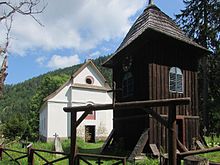Čierny Váh (place)
Čierny Váh is a place in northern Slovakia. The village belongs to the municipality of Kráľova Lehota .
location
Čierny Váh is located in a valley between the Low Tatras in the south and the Kozie chrbty in the north, through which the river Čierny Váh , the Black Waag, flows, after which the place was named. Coming from the northeast, the Ipotica brook flows into the Čierny Váh in the village. To the west of the village are the Čierny Váh reservoir and pumped storage plant .
history
The forest workers' settlement was founded in the first half of the 18th century . It was initially called Hošková. In 1897 the place was renamed Čierny Váh after the river of the same name. Ten houses belonged to the village, including isolated courtyards (Benkovo, Dikula, Medvedzia and Ráztoky). The main source of income for the residents was forest work . The river was used to transport logs down to sawmills .
In the first half of the 1910s the valley and thus also Čierny Váh was connected to the Považská lesná železnica , the Waagwaldbahn. From then on, the narrow-gauge railway was used for transporting trunks. In the 1970s, the population in the village was 136 people. At that time, next to the Najsvätejšej Trojice , Holy Trinity Church, built in 1803, there was a school and an inn in the village. From the second half of the 1970s, the lake Čierny Váh was dammed west of the village and a pumped storage plant was built.
Individual evidence
- ↑ poster Lesnicka osada Čierny Váh . Image file accessed on June 16, 2015.
- ↑ Jaroslav Grán: Pumped storage power plant Čierny Váh . 1983. Accessed June 15, 2015.
Coordinates: 49 ° 0 ′ 49.5 ″ N , 19 ° 56 ′ 28.2 ″ E
